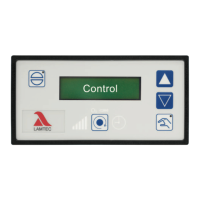
Do you have a question about the Lamtec ETAMATIC OEM and is the answer not in the manual?
| Power consumption | max. 5 W |
|---|---|
| Ambient temperature | -20 °C to +60 °C |
| Protection class | IP20 |
| Weight | Approx. 300 g |
| Supply voltage | 24 V DC ±20% |
| Input Voltage | 24 V DC ±20% |
Specifies the applicability and standards followed by the ETAMATIC OEM/S OEM.
Details safety symbols and operator responsibilities for safe operation.
Explains the connection and use of associated automatic flame guards.
Describes the startup sequence when no pilot burner is used.
Details the startup procedure when a pilot burner is utilized.
Instructions for connecting and using the programming unit for operation.
Information on using, connecting, and setting up the customer interface.
Essential settings and preparations required before system commissioning.
Procedure for selecting the display language for the unit.
Configuration of output channels, defining actuator types and behavior.
Configuration options for starting the burner with or without a pilot burner.
Setting the duration for the pre-purge phase of the burner cycle.
Configuring the delay time for the recirculation damper during pre-purge.
Option to disable the internal burner firing rate control unit.
Setting the running time for the TPS firing rate input.
Defining the minimum operating time for the fuel/air ratio control.
Setting the duration of the post-purge phase after burner operation.
Configuring the delay for air damper opening during the pre-purge phase.
Settings for serial interface parameters to ensure communication.
Option to disable the leakage test before ignition.
Configuring the pilot burner for maintenance mode and ignition attempts.
Setting up automatic burner restart after specific fault conditions.
Configuration of the internal burner firing rate controller parameters.
Procedures for setting various operational parameters and limit switches.
Process for entering and programming operating curves for the system.
Procedure to clear the system's memory and old curves.
Setting the ignition point parameters for burner startup.
Configuring the base firing rate for the burner.
Programming additional points for firing rate curves.
Process for saving programmed operating curves.
Modifying existing points within the programmed curves.
Re-determining range limits after programming or limit switch changes.
Retrieving CRC checksums for system verification.
Accessing and viewing the operating and running times of the unit.
Information and procedures related to system faults and error handling.
Steps to change the system access password for security.
Instructions on switching the display between different operating values.
Explains the system behavior and error messages during an O2 trim fault.
Details the consequences of air deficiency and required settings.
Procedures for manually resetting O2 trim errors.
Accessing and viewing the O2 trim fault history.
Describes automatic monitoring functions for O2 values during operation.
Overview of the developed trim strategies for combustion installations.
Diagram and information on connecting the O2 measurement device.
Explains operating modes and display interpretations for CO/O2 control.
Steps and parameters required for commissioning the O2 trim system.
Explains the function of the internal controller in calculating burner firing rate.
Overview of the integral firing rate control unit and its capabilities.
Setting limit values for burner operation and start-up.
Information displayed when actual temperature exceeds limits.
Procedure to adjust setpoints using the customer interface.
Steps to modify the setpoint of the power control unit via programming.
Details on the various analogue and digital input signals accepted by the controller.
Describes the burner start-up and firing rate control operation.
Instructions for handling steam pressure signals and PT100 input.
How to configure the controller for atmospheric condition-based control.
Methods for switching setpoints, including manual and automatic adjustments.
Detailed description of the burner's start-up sequence and related timers.
Configuration of thermostat function and control range settings.
How to operate the system in manual control mode.
Explanation of the different display modes and indicators.
Guidance on adjusting the burner firing rate controller parameters.
Understanding and setting the control range around the setpoint.
Procedure for testing and verifying the safety limiter function.
Provides guidance and examples for setting PID controller parameters.
Detailed procedure for performing the valve leakage test.
Glossary of abbreviations used in the programming unit display.
Information on flame monitoring options and their purpose.
Recommendations for proper installation to prevent EMC interference.
Comprehensive list of fault codes, their descriptions, and restart procedures.
How to check the status of digital inputs on the ETAMATIC OEM.
Visual representations of process sequences for different burner types.
Detailed wiring and connection diagrams for ETAMATIC OEM and related components.
Examples of how to connect for regular firing rate input signals.
Specifications for maximum allowed cable lengths for various signals.
Guidelines for connecting the unit in non-grounded power line networks.
Instructions and diagrams for connecting flame scanners and sensors.
Wiring diagram for connecting the customer interface to the ETAMATIC OEM.
Information on configuring and connecting the LAMTEC SYSTEM BUS.
Details on connecting a modem for remote control access.
Internal wiring diagram for the control output devices.
Specific instructions for venting the gas line over the roof during valve leakage tests.
Guide to using the switches and key combinations on the operating unit.
Information on connecting and selecting R.P.M. sensors for speed feedback.
How to externally switch fuel motors and valves using relay modules.
Guidelines for connecting feedback potentiometers and fail-safe feedback.
Procedures for replacing servo motors and potentiometers.
Steps and precautions for replacing the ETAMATIC OEM unit.
Instructions for removing, replacing, and inserting EPROMs and memory extensions.
Important notes and guidelines regarding cable shielding and wiring practices.
Procedure for running the system to check shut-off limits.
How to test and document tolerance limits in air deficiency direction.
Specifications and technical data for the ETAMATIC OEM and its components.
Information on using the unit without an integrated flame monitor.
Physical dimensions and weight specifications of the ETAMATIC OEM.
Declaration confirming compliance with relevant directives and standards.